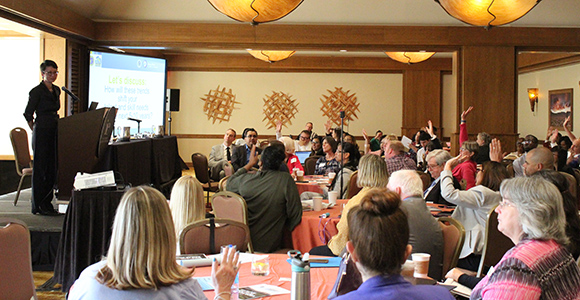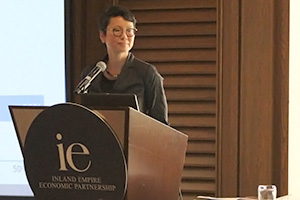
Future of Work MeetUp in Palm Desert (Photo: John Orta/Inland Empire Economic Partnership)
It doesn’t seem to matter what part of California you live in; people are worried about the impact of automation on jobs in their region.
The 13th Future of Work MeetUp this year was held in the Inland Empire in Palm Desert. And the education, workforce and community leaders who attended—like their colleagues in other regions of California—think that automation will noticeably disrupt their economy in the next five years.
Almost two-thirds of jobs in the region are “at risk” because of automation over the next 20 years, according to a 2017 analysis.
As one attendee flatly declared, “It is imperative that students be exposed to technology.”
It makes sense. 80 percent of the middle skills jobs in California already demand digital skills—and that percentage certainly isn’t going to get smaller.
The MeetUps are being sponsored by various local and regional leaders the California Community Colleges and California Forward.
The featured speaker at each of these meetings has been the executive vice chancellor for the Community Colleges, Van Ton-Quinlivan.
 She told the audience of about 100 that workers will have to keep acquiring skills in order to keep up with the fast-changing California economy or risk being left behind.
She told the audience of about 100 that workers will have to keep acquiring skills in order to keep up with the fast-changing California economy or risk being left behind.
The vice chancellor was promoting Governor Brown’s online statewide community college, which is aimed at helping California’s stranded workers upgrade their jobs skills.
The proposed college is designed to serve the needs of a large population of Californians that the massive community college system — the largest higher education system in the world — currently doesn’t serve.
“It is a flexible and affordable alternative for persons who cannot take classes at a community college campus,” she said. “It’s let them learn at a pace as fast as they want in a competency-based system.”
Much of the audience liked the idea.
Margaret Rueda, who works in the community college system, used to work at a Marine base where she labored to find active deployed military members online classes.
“This is an exciting answer for the active military,” she said. “I used to have Marine infantry members says ‘I have eight weeks in which I can take a class’. This will meet that need.”
Zeryl Becker works at the College of the Desert and she has taught online courses.
“I love the idea,” she said. “It’s a whole new approach to education.”
Of course, in remote areas of California like some parts of the Inland Empire, digital access can be a problem. And students need to be able to navigate the experience of online education.
Van Ton-Quinlivan acknowledged that and shared with the audience that part of the online community college introduction will be to ensure what she called “a high-support student experience.”
The online college plan, part of the proposed state budget that will be voted on this summer by the Legislature, will need to be culturally appropriate (many of the stranded workers are Spanish-language dominant) and have an aggressive onboarding for what are being called “non-digital natives” (people who don’t have a lot of experience learning online).
As Ton-Quinlivan emphasized, “California employers are struggling with their talent infrastructure.”
The online college is being designed to be part of addressing the challenge that the California Economic Summit has posed—how to train one million more middle-skills workers for the California economy, which will benefit employers and give more Californians the opportunity to find more and better paying jobs.

